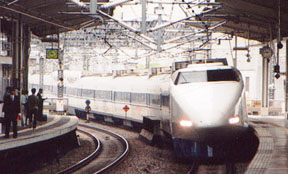
Travelling like a bullet
How do you like travelling to school by bus or car during the rush
hour traffic, getting crushed and trampled in the school bus or van, and
sweating heavily? Not a nice experience at all, is it?
Have you ever wondered how it would be to travel by train, not an
ordinary one, but in a train that travels at high speed? Today, we will
tell you about trains which travel at such high speed like bullets;
Bullet Trains! However they are called bullet trains not due to their
speed, but for their bullet-like shape.

These trains, or shinkasens as they are called in Japan, were
inaugurated in 1964 in Japan, in the year of the Tokyo Olympic Games.
The world's first high speed line had a speed of about 200km/h.
Now, the speed has increased to 300km/h. This line is known as
Tokaido Shinkasen and connects Tokyo, Nagoya, Kyoto and Osaka. The
extension of the Tokaido Shinkasen, Sanyo Shinkasen to Hakata station in
Fukuoka, was completed in 1975.The trains operating on the Tokaido/Sanyo
Shinkasen are of three categories.
The Nozomi train stops only at the most important stations. Hikari
trains stop a little more frequently than Nozomi trains. On the Sanyo
Shinkasen, Hikari trains are known as 'Hikari Railstar'. Kodama is the
slowest category of train and stops at all stations. The Shinkasen was
designed to provide high-speed transportation to large numbers of people
over long distances.
They proved popular not only among business people and employees
travelling to work, but also among tourists. For this reason, dining
cars and cars with special compartments for families and groups have
been introduced. In recent years, a growing number of people have begun
using the Shinkasen to go to work. To meet the demand for more seats,
'double-decker' cars have also been introduced.
Bullet trains are operated with the most advanced technology
available, to guarantee efficiency and safety. Most high-speed systems
take advantage of lower-tech solutions such as longer curves, trains
that are optimised for length and weight, and eliminating automobiles
crossing tracks. There are systems to automatically and centrally
control the trains' speed and the distance between trains. The trains
can also be stopped or slowed in emergencies.
Fact File
* Along the Tokaido line, 300 trains operate at a top speed of
270km/h or 168mph (since 1992).
* Along the Sanyo line, 500 trains operate at a top speed of 300km/h
or 186mph (since 1997).
* Between Hiroshima and Kokura, the bullet train covers the 192km or
120 mile distance in only 44 minutes. It averages a speed of 262km/h or
164mph, which is the fastest scheduled train service in the world. |


